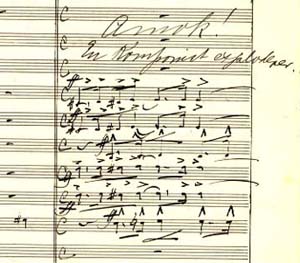Aspects & Points
Protest and absurdity - an example
Symphony No. 11 (1944-45), Symphony No.12 (1946) and Fri Klaversonate (Free Piano Sonata) (1945-46) marke the beginning of the fourth phase of Langgaard's career as a composer. In this phase he adopted a devil-may-care approach to his music, introducing an element of absurdy and protest against his own time, the Romantic tradition - and the composer's own situation.
Symphony No. 12 may be taken as an example:
- The symphony is in one movement, and lasts about 7 minutes. It begins as an ambitious Late Romantic orchestral movement, but then turns into a series of short sections. The ending comes as a bolt from the blue, and the movement is not 'rounded off'. It is a composition that puts down a major question mark to itself as 'art' and as a 'symphony'. Langgaard follows the tradition, while at the same time putting it to the test.
- The composer's ambivalent attitude to the genre and its musical expression may also be seen in the fact that he characterises it as "Raging", as well as in the title and the preface. The title is Helsingeborg. In his preface, Langgaard writes that this refers to the "delightful town" of Helsingborg (in Sweden), but also to the term "Helsinge" - supposedly a Swedish expression for Hell, the place where Hel, the god of death, dwells, and where the lazybones are given rockets up their backsides! This absurd ambiguity is typical of Langgaard's later period.

- This ambiguity also takes on a personal aspect. At the end of the score Langgaard wrote that the symphony is his
Symphony No. 1 "composed again in a more concentrated form". It consists of five sections, corresponding in tonality
and 'mood' to the five movements of Symphony No. 1, which lasts an hour, though without quoting from it directly.
However, whereas Symphony No. 1 ends with a movement entitled Livsmod (Love of Life), in 1946 Langgaard found himself in a situation where this optimism was no longer present, and he therefore characterised the sudden ending of the later work with the phrase "Amok! A composer explodes", an expression of desperation and powerlessness. In this way the composition was also given an 'autobiographical' content.
![]()